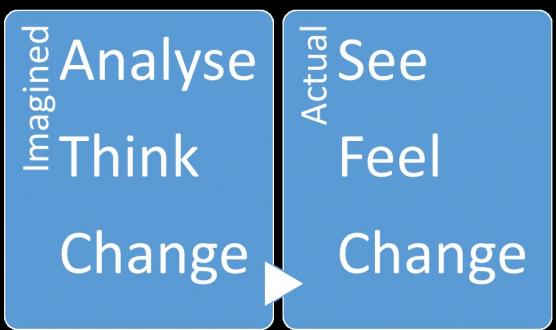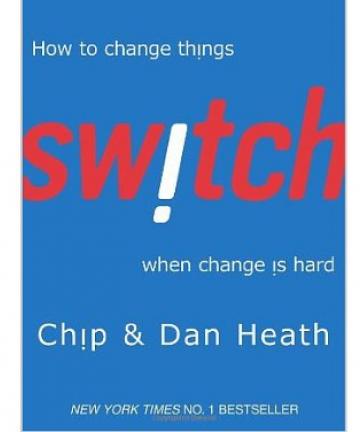"In a Nutshell" book review of 'Switch' by Dan and Chip Heath
"In a Nutshell" book review of 'Switch' by Dan and Chip Heath
Switch - How to change things when change is hard
Who Is The Book For?
The Heath brothers come from a psychology background (they are both professors at two different American universities) and they approach change from an individual behavioural basis. Because of this, the principles they talk about have a wide utility. They are targeted at managers in business and this book will be found useful by Chief Executives seeking culture change but will also be applicable to a supervisor dealing with a difficult colleague. The principles would also be useful in the public sector, by teachers and even by parents.

The Ideas in a Nutshell
Bringing About Change
Many, if not most of us have some sort of rational model in our heads about effective business change. It often starts with some analysis of the current situation. This is followed by education of employees to change the way that they think about something which leads to a different set of behaviours. In fact it rarely happens like that say the authors, our brains just don’t work that way. It is much more likely, because organisations are made up of human animals, that emotion is involved especially if the change is a significant one.

It is more likely that when we change it is because we see something which causes us to feel a different way and this brings about a change in our behaviour. Change that happens this way can happen very quickly and more important it is less likely to become exhausting to our emotional sides. The key then is to Find the Feeling.

Implement
We have experience in all sectors and functional areas
of business. We have been lucky to work with some of the most talented leaders and managers in the UK. Some of their experience along with ours has helped develop these articles.
Our focus is typically in operational areas of business and our successes include:
Cycle Time Reduction
Cost Reduction
Rework Reduction
Error and Checking Elimination
Throughput Improvement
Productivity Enhancement
Improved Client Communications
However these cannot be successfully delivered without the strategic, behavioural and cultural elements present in all organisations.
Please call us on 020 7739 6565 to discuss how we can help you or click here to complete a contact form.
The Metaphor
The Heaths set out and detail a metaphor that was borrowed from Jonathon Haidt (The Happiness Hypothesis):
Haidt says that our emotional side is an Elephant and our rational side is its Rider. Perched atop the Elephant, the Rider holds the reins and seems to be the leader. But the Rider’s control is precarious because the Rider is so small relative to the Elephant. Anytime the six-ton Elephant and the Rider disagree about which direction to go, the Rider is going to lose. He’s completely over-matched.
The Elephant’s hunger for instant gratification is the opposite of the Rider’s strength which is the ability to think long term, to plan, to think beyond the moment. What is perhaps surprising is that the Elephant also has enormous strengths and the Rider has crippling weaknesses. The Elephant isn’t always the bad guy. Emotion is the Elephant’s turf – love and compassion, sympathy and loyalty. That fierce instinct to protect your children from harm, that’s the Elephant. If you’re planning change, the Elephant provides the drive and energy to get things done.
The Heath’s believe that to effectively bring about change we must address the emotional as well as the logical reasons for change, that is we have to Motivate the Elephant, Direct the Rider and Shape the Path.
What Do They Recommend?
For things to change in an organisation people need to act differently. Picture these people, who are they; how should they behave in future? With these people (and yourself) in mind we must appeal to both their emotional side (The Rider), their rational side (The Elephant) and also consider the environment and clear the way for them to succeed (Shape the Path). The Heaths make some very specific suggestions about how to do this.
Motivate the Elephant
Find the feeling
Knowing something isn’t enough to cause change. We have to make issues really visible, get people talking about them. One demonstration with emotional impact will be better than a hundred spreadsheets.
Shrink the Change
Break down the change until it no longer spooks the Elephant. Perhaps the change isn’t as scary as it first appears
Grow Your People
Cultivate a sense of identity and instill the growth mindset. Getting people to make small changes can help them think that change is possible, and that they are people that actually welcome change
.
Direct the Rider
Find the Bright Spots
Find out where it’s working and clone it. If change has happened find out how, encourage it to be copied and promote it widely. Too often we concentrate on failure
Script the Critical Moves
This is not about the big picture but specific behaviours. What is the one thing I MUST do? – take the choice away and make this policy.
Point to the Destination
Change is easier when you know where you are going and why. Here we talk about the objective as opposed to providing lots of data for the Rider to obsess over.
Shape the Path
Tweak the Environment
When the situation changes, the behaviour changes. Crucially we attribute the way people behave in a situation as being about their character or personality when it is not (Fundamental Attribution Error). People issues often turn out to be environment issues.
Build Habits
When behaviour is habitual it is free – no longer difficult. Create action triggers that encourage behaviours without pausing to think.
Rally the Herd
Behaviour is contagious – help it spread. Let people know about the good things happening – like putting a few coins in the tips jar. If I encourage my colleagues to do what I did, then I am more likely to continue and so are they.
Will I Enjoy Reading The Book?
The brothers Heath have a very engaging way of writing and they carry you along without losing the overall structure and plot. All of the principles are illustrated liberally with interesting anecdotes and real world examples. The underlying research is made available but not thrust down your throat. This is a very enjoyable read, quite light and a metaphor itself of how to bring about change – engaging the emotional mind as well as the rational mind.


